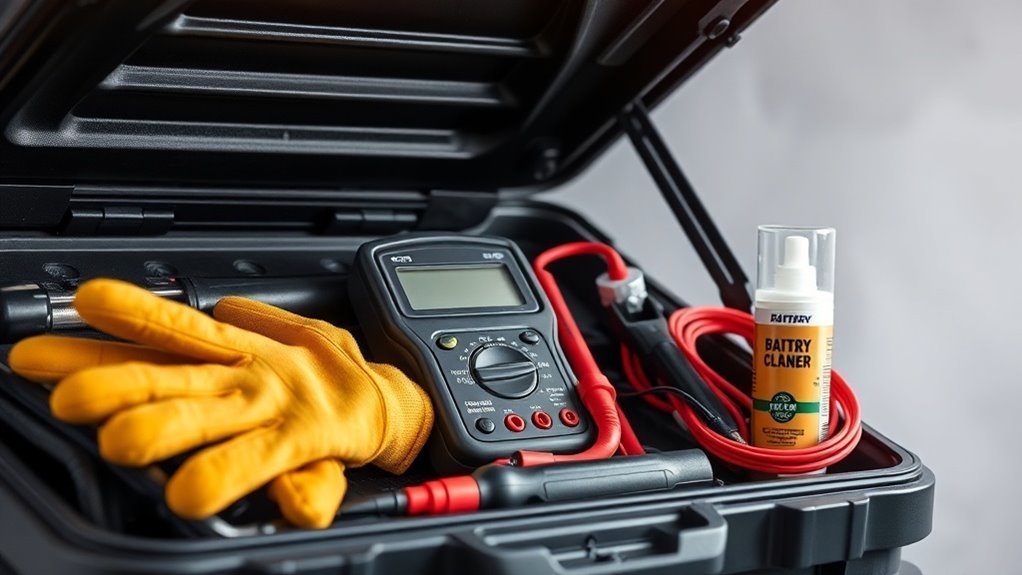Understanding Car Battery Safety Tools

When handling car batteries, it’s essential to use safety tools like goggles and gloves to protect yourself from corrosive materials and acid splashes. Non-conductive clothing reduces the risk of electric shock, while having a fire extinguisher on hand is important due to flammable gases. Use battery testers to check health and performance. Knowing the proper techniques for disconnecting and connecting batteries can prevent accidents. Learn more about best practices and common hazards to guarantee your safety.
Key Takeaways
- Always wear safety goggles to protect your eyes from acid splashes when handling car batteries.
- Heavy-duty gloves are essential to shield your hands from corrosive materials during battery maintenance.
- Use non-conductive clothing to minimize risks of injury from accidental terminal contact.
- Keep a fire extinguisher on hand due to flammable gases that can accumulate around batteries.
- Regularly check and maintain battery health with tools like testers to prevent unexpected failures.
The Importance of Battery Safety Tools
When it comes to handling car batteries, safety tools are vital. You wouldn’t want to risk injury or damage while working on your vehicle.
Whether you’re jump-starting a battery or replacing it, having the right tools can make all the difference. Wearing safety goggles prevents eye injuries from battery acid splashes, and gloves protect your hands from corrosive substances.
Having the right tools, like safety goggles and gloves, is crucial for safe battery handling.
A sturdy battery charger guarantees you won’t shock yourself during the process. Additionally, using insulated tools minimizes the risk of short circuits.
It’s essential to familiarize yourself with these tools and their proper use, as neglecting them can lead to dangerous situations. Prioritizing safety with the right tools not only protects you but also enhances your efficiency while handling car batteries. Furthermore, using tools like circuit testers can provide confirmation that electrical systems are safe to work on before starting any maintenance tasks.
Essential Safety Gear for Battery Handling

A few essential pieces of safety gear are critical for handling car batteries safely.
First, always wear safety goggles to protect your eyes from acid splashes or debris. Heavy-duty gloves are equally important; they’ll shield your hands from corrosive substances and prevent electric shocks.
Using thick, non-conductive clothing helps minimize the risk of injury from accidental contact with terminals. If you’re working in a poorly ventilated area, a respirator can protect you from harmful fumes. Additionally, it’s crucial to remember that effective respiratory protection during battery handling is essential to prevent long-term health issues.
Finally, having a fire extinguisher nearby is significant, as batteries can produce flammable gases.
Battery Testers: Ensuring Optimal Performance
Understanding how to safely handle car batteries is just the beginning; ensuring they perform at their best is equally important. Battery testers help you assess the health and charge of your battery before it leaves you stranded. These tools can identify issues early, saving you time and trouble down the road.
| Battery Tester Type | Function |
|---|---|
| Digital Tester | Provides precise voltage readings |
| Load Tester | Simulates a load to evaluate performance |
| Conductance Tester | Assesses internal resistance and overall health |
Proper Techniques for Disconnecting and Connecting Batteries
Disconnecting and connecting a car battery safely involves a few key steps to prevent accidents and guarantee proper functionality. You’ll want to follow these techniques closely:
- Turn off the engine and all electronics: This reduces the risk of sparks during the process.
- Disconnect the negative terminal first: Always remove the negative (-) cable before the positive (+) to prevent short circuits.
- Reattach the positive terminal first: When connecting, this order helps minimize electrical risks.
Common Battery Hazards and How to Avoid Them
When working with car batteries, it’s important to recognize the potential hazards involved.
First, be aware of acid spills. Battery acid can cause harmful burns, so always wear gloves and goggles.
Second, avoid sparks and flames. Batteries can emit explosive gases, especially during charging, so work in a well-ventilated area and keep open flames away.
Third, handle batteries carefully; they’re heavy and can leak. Use tools designed for battery work, and don’t drop them.
Finally, watch for short circuits, which can lead to fires. Always connect and disconnect cables properly, starting with the negative terminal. Additionally, ensuring that personal protective equipment is worn can significantly reduce the risk of injury while working with batteries.
Best Practices for Storing and Maintaining Car Batteries
To guarantee your car battery remains in good condition, it’s essential to store and maintain it properly. Following a few best practices will help extend its life and effectiveness.
Here are three key tips:
- Keep It Charged: Regularly check the charge and avoid leaving it unused for long periods to prevent sulfation.
- Store in a Cool, Dry Place: If you need to store the battery, choose a location that’s stable in temperature—extreme heat or cold can damage it.
- Inspect Terminals: Periodically check for corrosion and clean the terminals with a mixture of baking soda and water to guarantee good connections.
Questions
What Are the Signs of a Failing Car Battery?
You’ll notice dim headlights, slow engine cranking, or electrical issues if your battery’s failing. Also, you might see corrosion around the terminals or a bloated battery case. Don’t ignore these signs; it’s time for replacement.
Can a Car Battery Explode During Extreme Weather?
Yes, a car battery can explode during extreme weather, especially heat or severe cold. You should always monitor your battery’s condition and temperature to prevent dangerous situations from arising, like leaks or even explosions.
How Long Does a Car Battery Typically Last?
A car battery thrives like vibrant summer leaves but can fade like autumn’s chill. Typically, it lasts three to five years, depending on weather extremes, maintenance, and your driving habits, so stay attentive to signs.
Are There Environmentally Safe Ways to Dispose of Old Batteries?
Yes, there are environmentally safe ways to dispose of old batteries. You can take them to recycling centers, automotive stores, or community hazardous waste events where they’ll guarantee proper disposal and recycling of harmful materials.
What Should I Do if the Battery Terminals Corrode?
If your battery terminals corrode, you should disconnect the battery, clean the terminals with a mixture of baking soda and water, rinse, dry, and then reconnect them securely to guarantee proper functionality.
Conclusion
In the world of car batteries, safety should never take a backseat. By using the right tools and techniques, you can avoid accidents and keep your battery in top shape. Remember, it’s better to be safe than sorry when you’re handling these powerful components. So, gear up and follow best practices to guarantee a smooth ride. With a little effort, you can drive away with confidence, knowing you’ve got battery safety down to a science!






